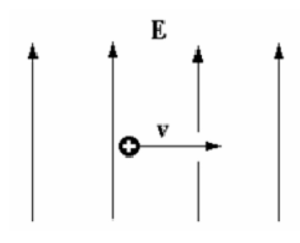Question
An ion with charge q, mass m, and speed v enters a magnetic field B and is deflected into a path with a radius of curvature R. If a second ion has speed 2v, while m, q, and B are unchanged, what will be the radius of the second ion’s path?
A) 4R B) 2R C) R/2 D) R/4
▶️Answer/Explanation
Ans:B
Solution: For this scenario, The circular motion is provided by the magnetic force. So that Fnet(C) = mv2/rqvB = mv2/r qBr = mv 2 x V → 2 x r
Question

An electron moves in the plane of the page through two regions of space along the dotted-line trajectory shown in the figure. There is a uniform electric field in Region I directed into the plane of the page (as shown). There is no electric field in Region II. What is a necessary direction of the magnetic field in regions I and II? Ignore gravitational forces.
| Region I | Region II | |
| A) | Toward bottom of page | Up on the page |
| B) | Toward top of page | Into the page |
| C) | Toward top of page | Out of the page |
| D) | Toward bottom of page | Out of the page |
▶️Answer/Explanation
Ans:C
Solution: In region I, the electric field pushes the negative electron with a force opposite the direction of the E field (out of the page). For the charge to not be pushed out, the magnetic field must create a force into the page to resist this. Based on LHRflat the B field must point up. Then in region II based on how the charge gets pushed, its magnetic force is up initially. Using LHRflat again in region II gives B field direction out of the page.
Question
A charged particle with constant speed enters a uniform magnetic field whose direction is perpendicular to the particles velocity. The particle will:
A) Speed up B) Experience no change in velocity
C) Follow a parabolic arc D) Follow a circular arc
▶️Answer/Explanation
Ans:D
Solution: Charges moving through magnetic fields move in circles as in the diagram for question 39
Question

An electron e and a proton p are simultaneously released from rest in a uniform electric field E, as shown. Assume that the particles are sufficiently far apart so that the only force acting on each particle after it is released is that due to the electric field. At a later time when the particles are still in the field, the electron and the proton will have the same
(A) speed
(B) displacement
(C) magnitude of acceleration
(D) magnitude of force acting on them
▶️Answer/Explanation
Ans:D
Solution: Not a magnetism question, but lets review. Since the charge magnitude is the same, they will experience the same forces based on Fe=Eq, but move in opposite directions. Since the masses are different, the same forces will affect each object differently so that the smaller mass electron accelerates more, thus gains more speed and covers more distance in equal time periods. So only the force is the same.
Question

A positively charged particle moves to the right. It enters a region of space in which there is an electric field directed up the plane of the paper as shown. In which direction does the magnetic field have to point in this region so that the particle maintains a constant velocity?
A) into the plane of the page
B) out of the plane of the page
C) to the right
D) to the left
▶️Answer/Explanation
Ans:B
Solution: By definition, E fields exert forces on + charges in the same direction as the E field. So the force from the E field must be UP. To maintain a constant velocity, this upwards force must be counterbalanced by a downwards force, which in this case it is to be provided by the magnetic field. With a + charge moving right, and a magnetic force down, RHRflat gives a magnetic field pointing out of the page.
